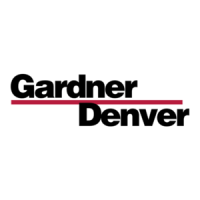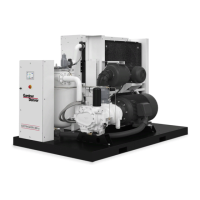Do you have a question about the Gardner Denver EBM Series and is the answer not in the manual?
Details on Gardner Denver's factory remanufactured air ends exchange program.
Defines DANGER, WARNING, CAUTION, and NOTICE symbols used throughout the manual.
Describes the rotary screw compression process with helical rotors.
Explains how oil is used for lubrication, cooling, and sealing rotors.
Critical warnings about electrical shock, pressure, and rotating machinery.
Warnings regarding equipment damage from improper operation or safety bypass.
Illustrations and explanations of various DANGER and WARNING decals.
Safety instructions and methods for safely lifting the compressor unit.
Recommendations for operating in cold weather, including heating and shelters.
Additional precautions for sub-zero temperatures, like shutters and heat.
Detailed steps and recommendations for lubricating motor bearings.
Essential checks for oil level, air filter, coupling, and piping before operation.
Procedures for verifying motor rotation and associated safety warnings.
General description of the microprocessor-based controller and its functions.
Explanation of Constant Run, Low Demand, Automatic, and Sequence modes.
Details on shutdowns for motor protection, high temperature, and phase imbalance.
Steps for navigating and adjusting controller settings via the keypad.
How the master/lag sequencing algorithm is established.
How setpoints are dynamically adjusted for effective compressor sequencing.
Overview of the oil system including cooler, filter, and separator.
Identifies causes and remedies for excessive oil consumption and carry-over.
Chart detailing maintenance actions and their recommended intervals.
Causes and remedies for compressor failing to start or stopping shortly after.
Resolving issues with compressor loading, unloading, and rapid cycling.
Diagnosing and resolving issues of low delivery pressure and high discharge temperature.
Identifying causes and solutions for excessive oil consumption and carry-over.
Further causes and remedies for oil carry-over, including temperature and valve failures.
Actions needed for advisories such as filter, separator, and oil changes.
Resolving shutdowns related to fan operation, overloads, and start errors.
Troubleshooting shutdowns caused by high temperature or pressure limits.
Troubleshooting shutdowns for high vibration, low oil pressure, and motor overload.
Actions for shutdowns related to thermistor and transducer open/short circuits.
Diagnosing issues with remote stop, shutdown, loading, and modulation.
Addressing erratic pressures, sequencing instability, and low oil pressure.
Details on Gardner Denver's factory remanufactured air ends exchange program.
Defines DANGER, WARNING, CAUTION, and NOTICE symbols used throughout the manual.
Describes the rotary screw compression process with helical rotors.
Explains how oil is used for lubrication, cooling, and sealing rotors.
Critical warnings about electrical shock, pressure, and rotating machinery.
Warnings regarding equipment damage from improper operation or safety bypass.
Illustrations and explanations of various DANGER and WARNING decals.
Safety instructions and methods for safely lifting the compressor unit.
Recommendations for operating in cold weather, including heating and shelters.
Additional precautions for sub-zero temperatures, like shutters and heat.
Detailed steps and recommendations for lubricating motor bearings.
Essential checks for oil level, air filter, coupling, and piping before operation.
Procedures for verifying motor rotation and associated safety warnings.
General description of the microprocessor-based controller and its functions.
Explanation of Constant Run, Low Demand, Automatic, and Sequence modes.
Details on shutdowns for motor protection, high temperature, and phase imbalance.
Steps for navigating and adjusting controller settings via the keypad.
How the master/lag sequencing algorithm is established.
How setpoints are dynamically adjusted for effective compressor sequencing.
Overview of the oil system including cooler, filter, and separator.
Identifies causes and remedies for excessive oil consumption and carry-over.
Chart detailing maintenance actions and their recommended intervals.
Causes and remedies for compressor failing to start or stopping shortly after.
Resolving issues with compressor loading, unloading, and rapid cycling.
Diagnosing and resolving issues of low delivery pressure and high discharge temperature.
Identifying causes and solutions for excessive oil consumption and carry-over.
Further causes and remedies for oil carry-over, including temperature and valve failures.
Actions needed for advisories such as filter, separator, and oil changes.
Resolving shutdowns related to fan operation, overloads, and start errors.
Troubleshooting shutdowns caused by high temperature or pressure limits.
Troubleshooting shutdowns for high vibration, low oil pressure, and motor overload.
Actions for shutdowns related to thermistor and transducer open/short circuits.
Diagnosing issues with remote stop, shutdown, loading, and modulation.
Addressing erratic pressures, sequencing instability, and low oil pressure.
| Brand | Gardner Denver |
|---|---|
| Model | EBM Series |
| Category | Compressor |
| Language | English |











